review: Olympus OMD EM5 Mk II
2021.03.04 (updated : 2024.02.24)
why a camera review in 2021
This has been my main camera since 2015. Because I've just decided to commit to the micro-four-third platform as long as we both exist I thought I'd share some thoughts on the E-M5. Perhaps it's nuts to write about cameras in 2021 when the market's collapsed and will never return. But I enjoy writing and I enjoy photography and can't really help myself.
I don't mind the collapse of camera photography; in fact I think it's great that more people than ever are taking photos - even if it is just on a phone that robs the experience of craft and comprehension. I use a camera because I'm doing mostly low-light urban landscapes, and mostly with manual focus lenses. These have a tactile element. Despite the obvious fact that software is eating photography, I can't stand the software-first nature of cell phone photography. Perhaps it's due to my having worked in software for thirty years. I also don't like the way phones push people to hurry their photography. For me, photography should take time; it's creative and it's okay if that takes time. And I don't care at all for the straight-jacket of social media photography outlets like Instagram.
I realize that puts me at odds with .. well, effectively all of society. So here goes, a view from a stool in the corner of class, well outside the interest of most photographers and certainly any manufacturer. Who knows, with the ongoing collapse of the market and its players, this may be one of the final amateur camera reviews ever written!
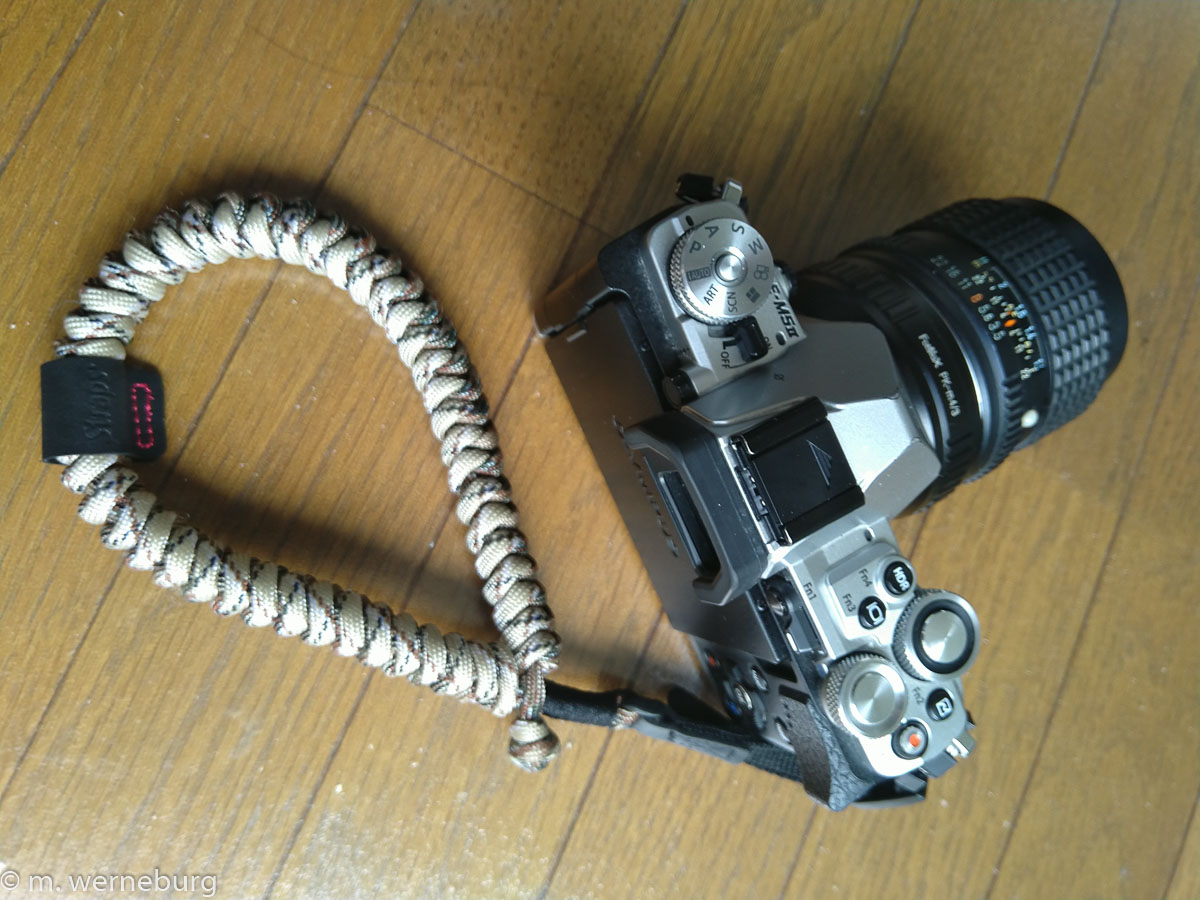
hello, gorgeous
how I chose the camera
I'm a fairly big guy. I stand at 6'5" and my hands are large enough that I can pick up a basketball one-handed. And yet I use one of the smallest full-featured interchangeable-lens cameras on the market. My choice stemmed from a few things:
- Wandering the city with a camera is my main use. As I say, "urban landscapes". Because I work long hours, and because daylight is boring anyway, this is increasingly happening in dawn and dusk - as a photographer, I'm a crepuscular animal.
- I take few photos of the family, and like everyone else I take those with my phone. If I go to a family event, I'll bring a camera and a strobe.
- I don't shoot video.
- I travel, but with small kids and the economy having been the way it's been for the past dozen years, less than I'd like. And when I do I like to travel light.
When it comes to camera implementation, my preferences are:
- Manual control dials, especially exposure compensation.
- "Good enough" image quality for what is a hobby, not a living.
- A well-made body that would last, and that had a swiveling rear screen.
- A decent choice in lenses for the new system, but also to support my old manual lenses. This included Pentax K-mount and Minolta A-mount stuff from the '70s and '80s.
- In-body sensor-based image stabilization was a nice-to-have on my list due to this preference, but I realize now that I grossly underestimated the impact of this feature: it's a must-have.
- Support my old external strobes, which required a PC port.
lens and sunk cost (fallacy)
As you can see, I stood a chance of making the most of my sunk costs for old lenses. Sunk cost is not what I'd consider an appropriate reason for making choices when you're trying to justify the continuation of a certain activity; that's called the sunk-cost fallacy. And supporting old lenses is something that all mirrorless platforms do, so it wasn't a distinguishing factor for this camera. What's more, the reality is that those lenses had been cheap to begin with, but I realized that I could spend a bit more on the body because I wasn't going to spend much on the lenses. If you're purchasing something like a camera - which no-one really needs in the smartphone era - you have to understand your needs and derive from that your budget.
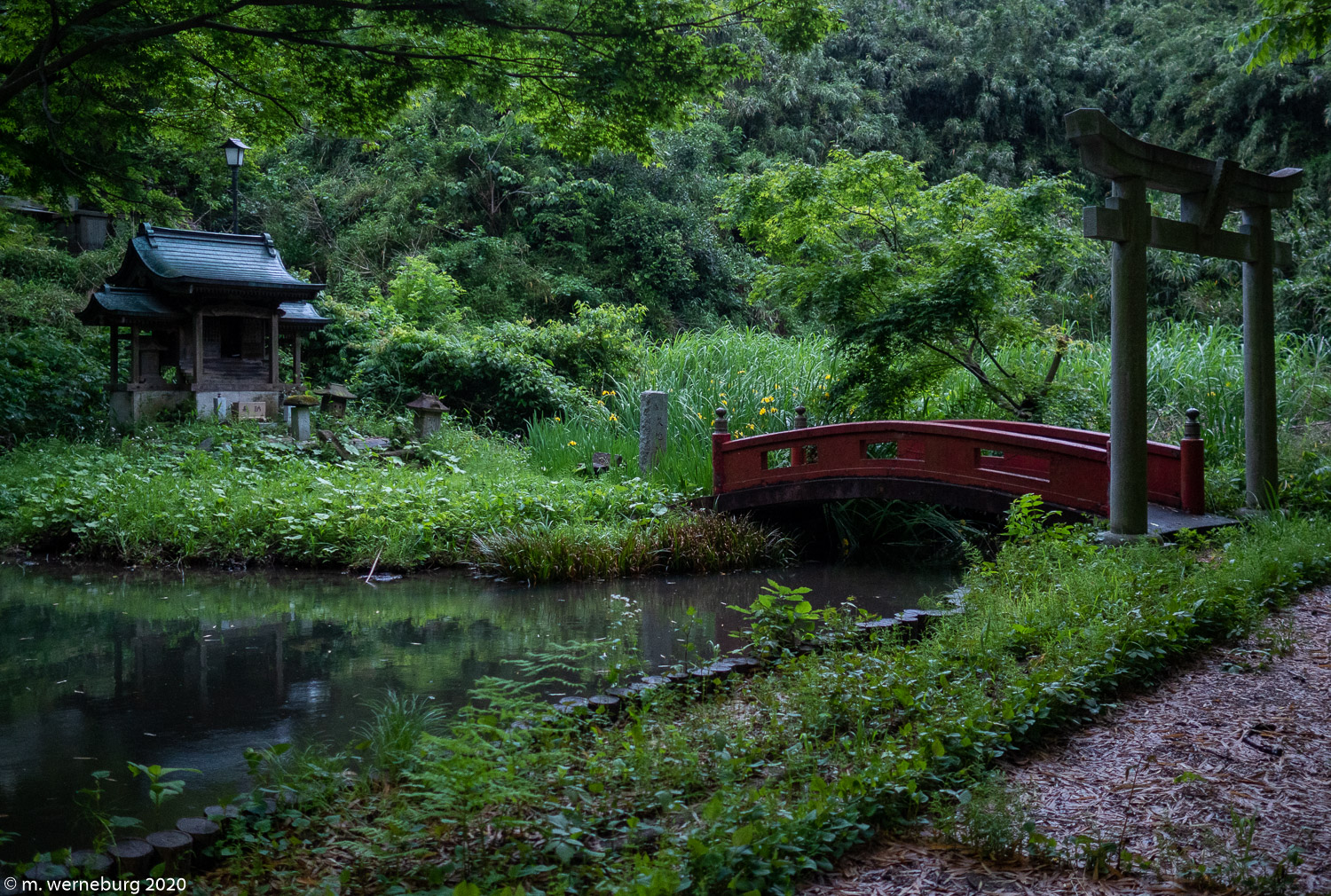
taken with autofocus 17mm lens & a cheap Slik tripod (that I hate)
image quality
Software is transforming photography. It's not the absurd little sensors in smartphones that are killing the camera industry. It's the processing of the images in the phone. It's the ability to instantly share photos. It's the global network of sites. It's the apps.
The sensor in the E-M5 MkII is not competitive in today's market. The same form factor now has millions more pixels. APS-C and full-frame have much larger photo receptors, which means they have better dynamic range and color fidelity and so on. Full-frame systems do a better job with operating in low light period, which is one of the primary use cases I'm struggling with in my photography.
But software is increasingly rendering the hardware differences moot. There is noise reduction technology out there that is simply astonishing. Digital manipulation as a whole has gotten to the point that flawless images can be had from just about any source. To get a sense of how far this has gone, I used some modern software to re-scan some very old images in early 2020 using a scanner from 2004. The results were amazing.
I decided that I could live with somewhat reduced hardware capabilities because software was going to erase the difference. Better to save some money on the cost of a full-frame system and put that money instead toward a computer for photo editing.
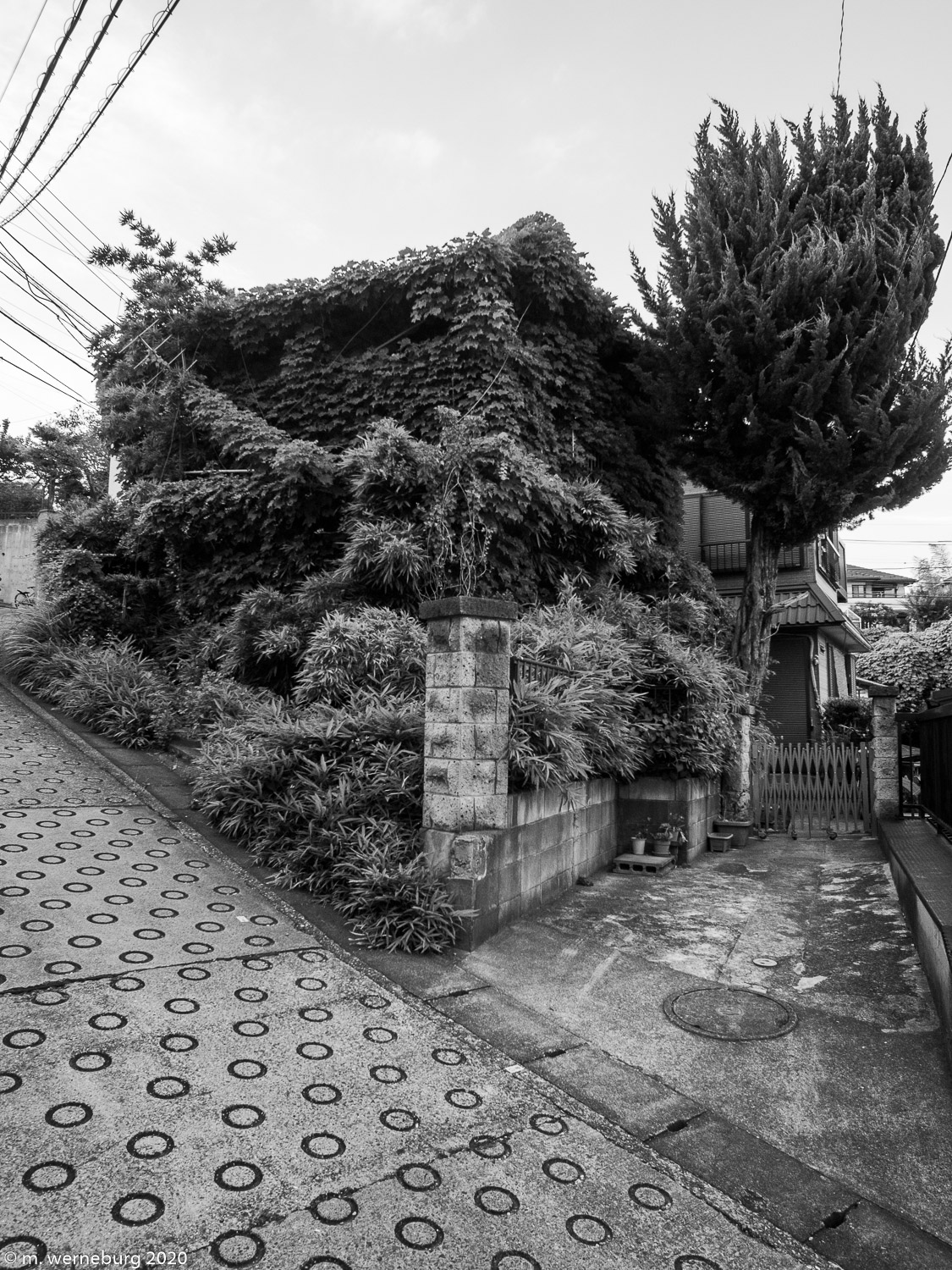
shot with the Rokinon 12mm f/2
picking the E-M5
In 2015, my wish-list didn't leave a lot of options. Mirrorless cameras were still a bit new, and APS-C camera bodies were still mostly designed around mounts made for full-frame lenses. For instance, the Pentax *ist DS I'd been using previously was built around the KAF2 mount which was compatible with lenses going back to the '60s. But that body's support for older lenses was spotty - they would mount but the camera wouldn't take an exposure reading without actuating the aperture. I was effectively taking each photo twice. I didn't know it when I started out, but I was heading for Olympus's E-M5 which had been designed with "retro" cues. I didn't care so much about the styling, but they'd fleshed out that retro vibe with features that supported my lust for manual. Other options included the Fuji line, which was still quite new and which frankly felt a little rough in the hand.
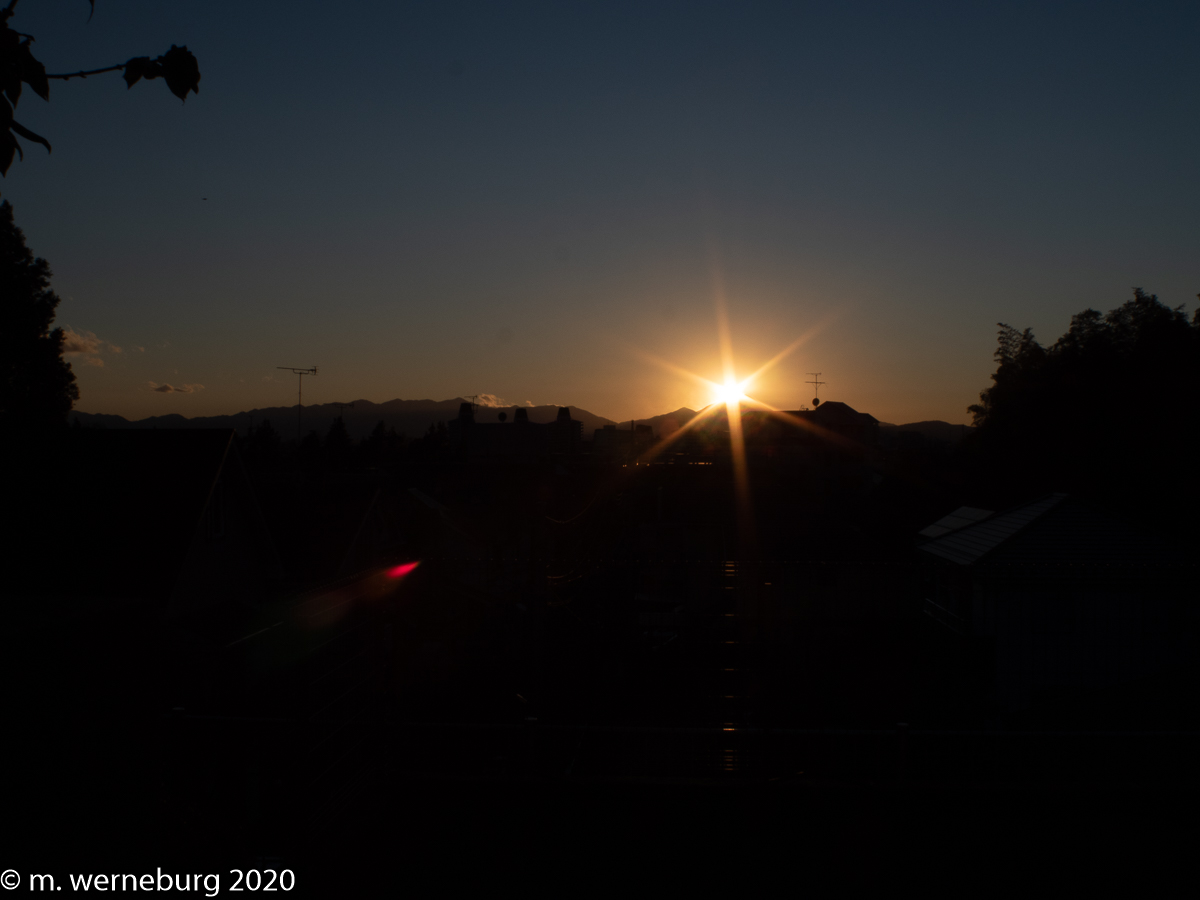
I knew what I wanted from a new camera, and also what I didn't. The latter included:
- video
- super-zoom
- a pentaprism viewfinder
- high frame-rate per second
- cutting-edge autofocus
There were also some things I just couldn't afford, including a system built around a full-frame sensor.
I read everything I could about the camera line from Olympus in addition to just about everything else on the market. I decided on the E-M5 MkII body and the 17mm lens (equivalent to a ~35mm lens on full frame). It looked great, and I could live with the expected trade-offs: not having very high resolution images offered by "full frame" sensors; losing a bit of high dynamic range capture; losing very shallow depth of field; losing some low-light ability; and maybe losing a bit of contrast.
It was the features, capabilities, and the design of the product that sold me on the camera. It fit within my budget because I'd only be buying the one lens. And I knew I could live with the expected trade-offs.
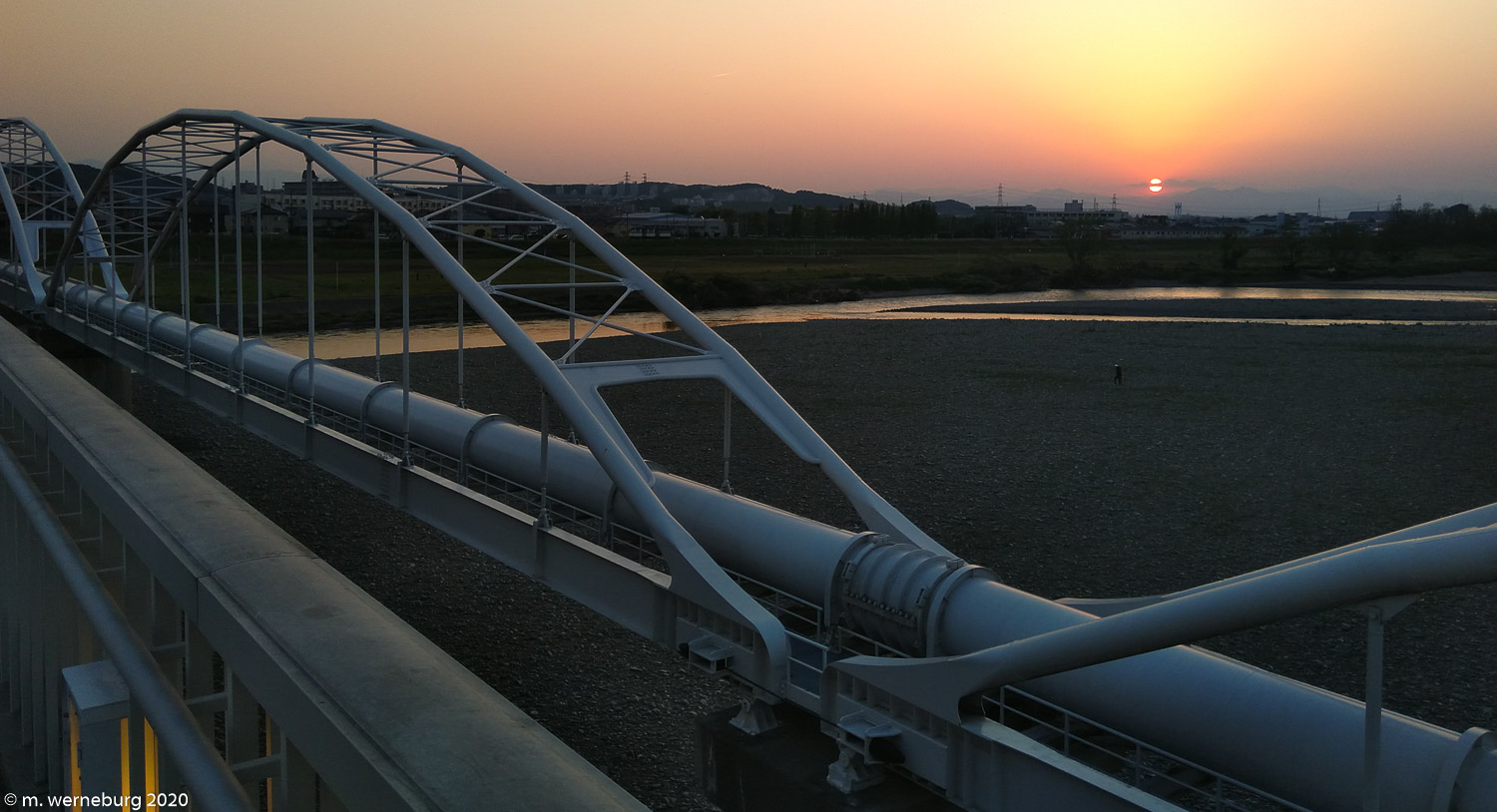
handles low light well enough - hand-held at sunset
using the camera
Virtually every camera on the market makes fantastic images. That's table-stakes. So I'll focus on using the camera. I've enjoyed using this camera quite a bit. It has a great heft and balance to it. Because the body is small, I find my little finger curls beneath the body somewhat uselessly. Small bodies, even solid-metal ones, can be tricky to hold steady which becomes an issue in low light. This small camera system can be supported with even small tripods, and I've used tripods ranging from a Joby to a heavy Manfrotto. I saw the Moon rising one evening and grabbed my lightweight Slik F740, an awful tripod I'd originally bought to support strobe units when I was learning to photograph diamond jewelry for a business that failed. This was the result (of the photography, not the business):

made with Minolta MD 80mm
From the time I bought the camera until very recently I've used a hand-strap on this body. This ironically added bulk and weight to the tiny camera body, but I found it helpful to have the weight balanced across the span of my hand and not on the tiny grips. I've now put that hand strap on my daughter's E-M10, as I'm worried about her dropping the thing. I got the wrist strap that appears in the pics on this page; it doesn't balance the camera's weight as my hand strap did, but does free up the tripod mount.
the viewfinder
Awesome. If you want to get a sense of how great modern electronic viewfinders have become, head to a camera store and compare virtually any EVF with a pentaprism DSLR - if you can find one.
controls
All of the individual controls are a pleasure to use; they have nice tactile response and make nice little sounds. Compared to the E-M10, which I also own, I can see that Olympus went up-scale with the E-M5 compared to the more clunky thunk-thunk of the E-M5. I can have it either way. .I've handled some other modern cameras and found their buttons have the wrong kind of play. I've also found some of the sexy dedicated exposure compensation dials on bodies from Fuji too stiff to use effectively. So, great work Olympus!
But this camera has too many buttons and dials. In 5.5 years, I have never used at least two of the buttons, one of the switches, and several of the "modes". The two-dial system is very useful. But if you have the camera in aperture mode, you can't use both dials with a manual lens: you can set one to exposure compensation but the other is reserved for the aperture - which is on the lens. I'd prefer to have aperture compensation and ISO but that option's just not available in the menu.
That said, I get the results I want by leaving the camera in aperture-priority mode and setting the ISO to "auto". I routinely use polarizers and routinely use both exposure adjustment and ISO bracketing. I might use the bracketed shots one time in ten, but because I'm working mostly in interesting lighting conditions, I like to have the option.
Regarding controls, here's what I've arrived at:
- Fn1 - enable/disable bracketing. This button isn't easy for me to reach, as it's recessed and set into the place where a switch is mounted on the camera.
- Fn2 - focus peaking. I didn't know what this was when I bought the camera but as I turn fifty you can bet I use it all the time.
- Fn3 - "my settings" mode. The camera supports four stored alternate profiles. I use one - a monochrome mode with a yellow filter.
- Fn4 - this button has "HDR" written on it, but I use it as an AEL button. It's the largest of the buttons around the top-right of the camera.
- Record - I've set this to bring up the ISO and white balance settings. I'm not sure I would use this camera to record video even if I liked video, it seems like a mirrorless camera is neither here nor there for video. Isn't that why we have smart phones on the one hand and professional video equipment on the other?
I use one of the four "my settings" saved profiles available - I use that slot for a monochrome profile with a yellow filter. This I usually use when shooting architecture.
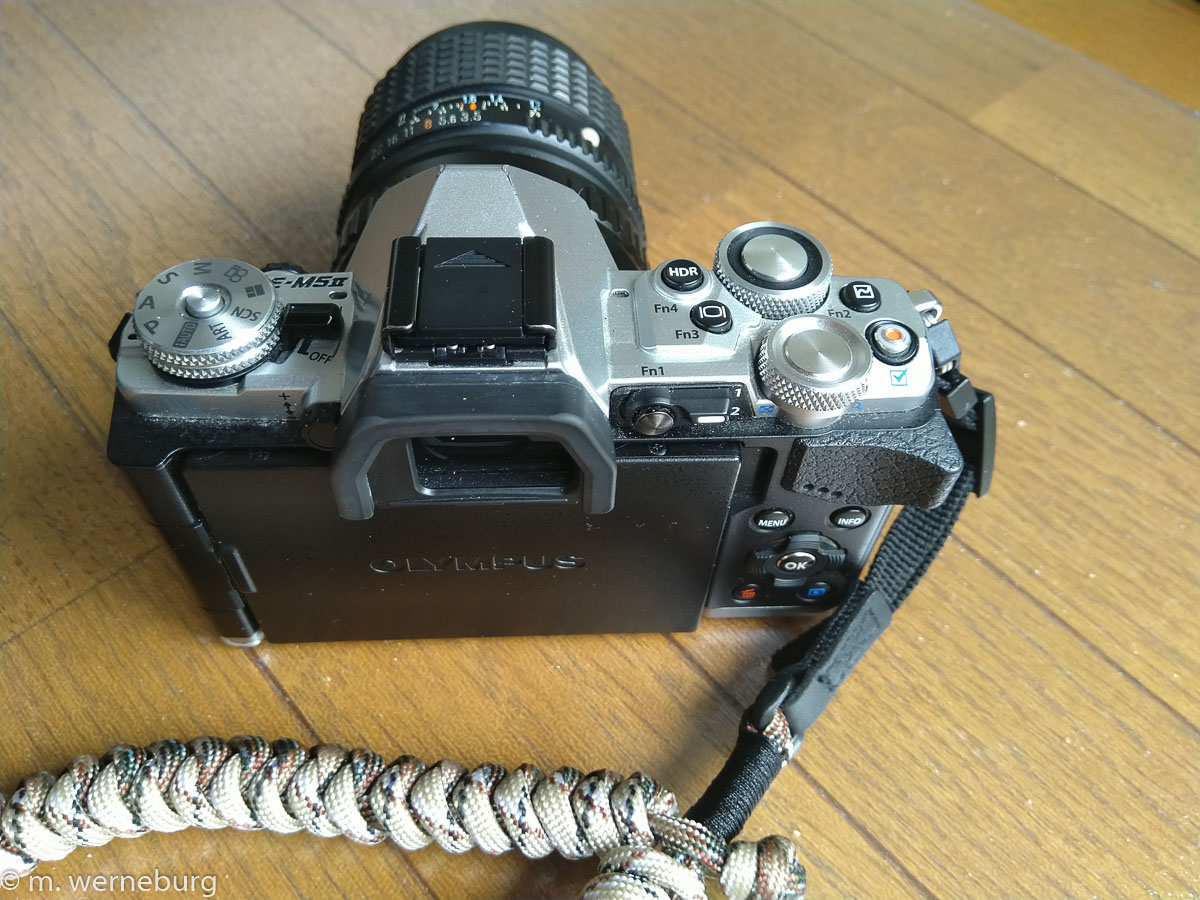
comparing with the E-M10
I'll again refer to the Olympus OMD E-M10 MkII, which I've bought (used) for my eight-year-old daughter. The cheaper body has a different layout with firmer chunky dials and fewer buttons (and no switch!). When using that camera, I find I don't miss the additional buttons at all, and even prefer those clunky dials. The E-M10 has less image stabilization capability, and no PC port, and the screen doesn't swivel - but that camera produces similar images and otherwise supports the same lenses. I'm a middling-level enthusiast photographer and I suspect that the modern incarnations of the E-M10 are enough camera for me.
I predict that the E-M5 as a product is finished with the MkIII: it is simply too perfect, competing with the flagship E-M1 model (and even exceeding it in button count); also, the E-M10 is rapidly filling the role of star model of the line-up.
The result is a DSLR body boiled down to mirrorless dimensions: something had to give but the designers crammed it all in. Meanwhile, the E-M10 MkIII now has the same sensor, same anti-shake, similar manual control dials, same menu, a more-advanced processing engine, and the same electronic viewfinder - all with a less complicated interface. In fact the E-M10 has become the top-selling camera in Japan for the past two years, something explained well in a video by Robin Wong, a former Olympus brand ambassador. I suspect that OM, the "brand" being spun up by the new owners of the Olympus camera line of business, will cancel the model.
lenses
This camera is supported by a range of amazing little lenses from Olympus, Panasonic, and third parties. For instance I have a Rokinon 12mm that's a treasure.
the "flash"
The tiny included strobe unit that comes with the camera is certainly welcome but it's so feeble I've found it useful only for things like fill lighting at close range. To get real illumination, I've used a couple of different portable external flashes, mounted via an adapter that protects the camera from potentially high voltage discharged into the mount by the flash. This adapter is attached to the camera via the PC port. It is extremely important not to attach an old strobe to a new digital camera directly. The way the old strobes worked was through an enormous discharge of electricity - sometimes more than 100V at one time. This will, of course, fry your camera. To get around this I use a "cold shoe" adapter that shields the hot shoe on the body. The top of this adapter has its own "hot shoe" that's attached to the camera's PC port (sometimes called a synchro port or other names). The following two photos show this set-up.
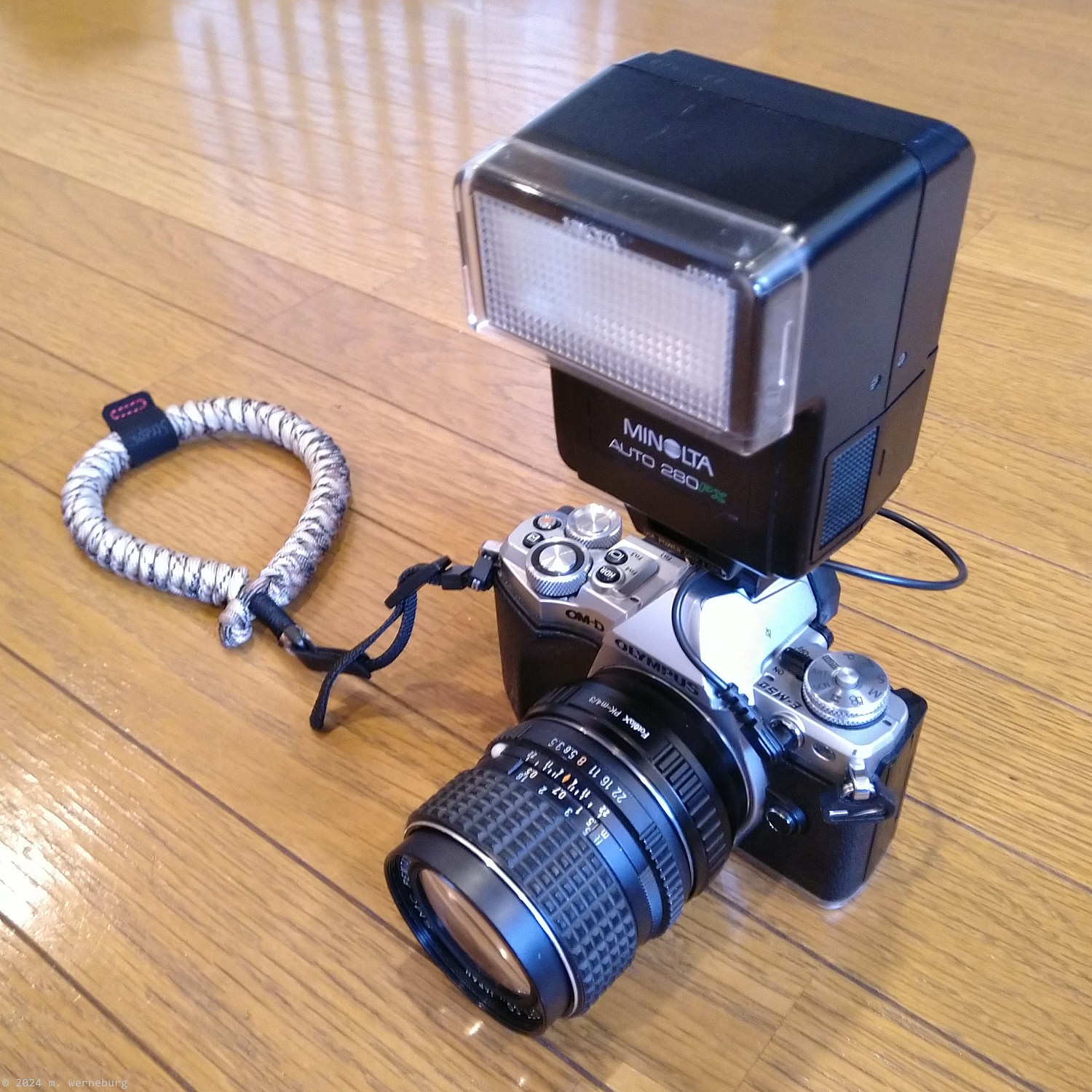
Using the PC/syncro cable
The adapter typically costs around $15. A far cry from the $600 for a modern Olympus strobe.
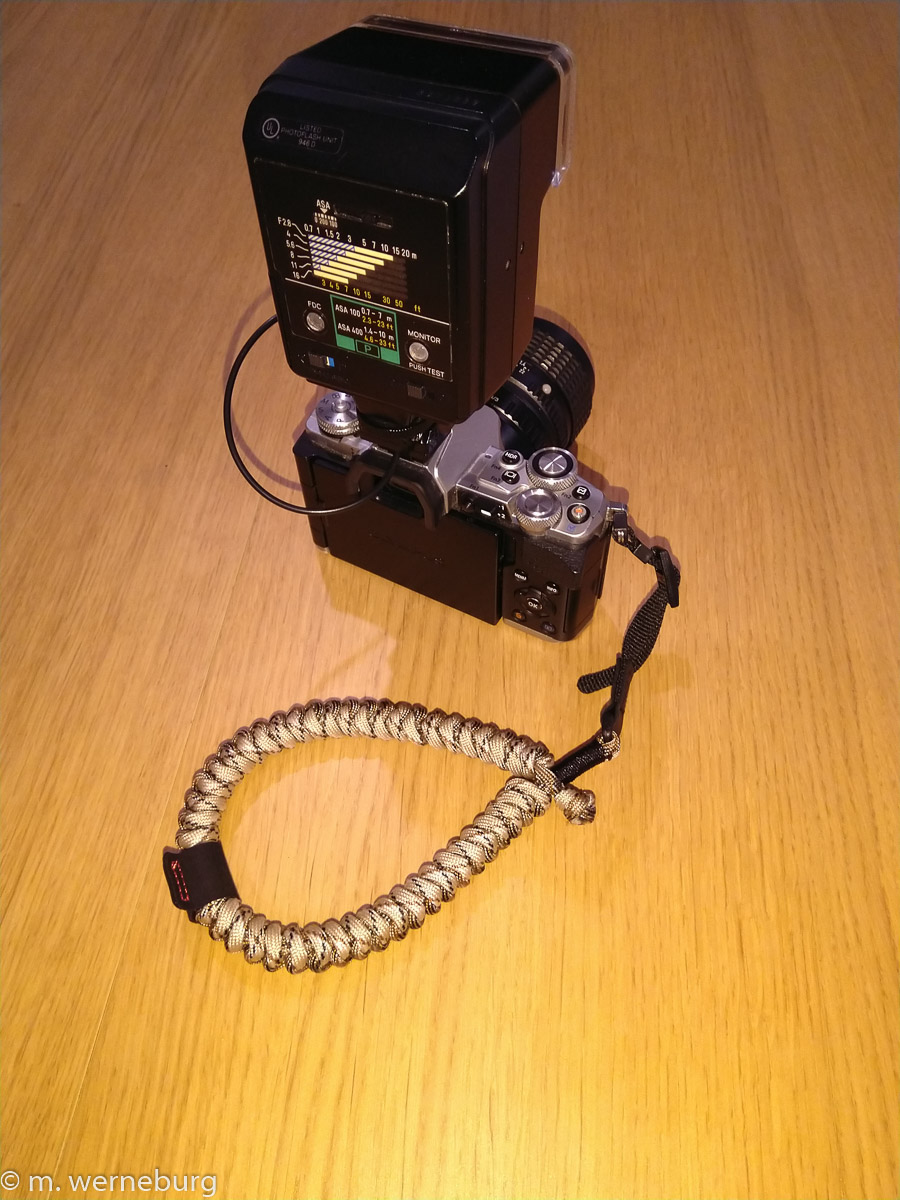
Play safe with old strobe units
stabilization
This camera's in-body stabilization is simply amazing. One night in 2020 I was out for a walk, primarily to get some exercise during the pandemic lockdown, but also to get out of the one-room hotel room I was "living" in. I had my plastic-fantastic hand-pinching Slik tripod* with me but I was separated from the shot I wanted to make by a chain-link fence. Kawasaki is an amazingly windy place in springtime, and I knew that shake was going to be a problem. I got this shot by hanging the camera & tripod on the fence. You can see from the traffic lights that the city was well into twilight.
*How many camera reviews have a villain?
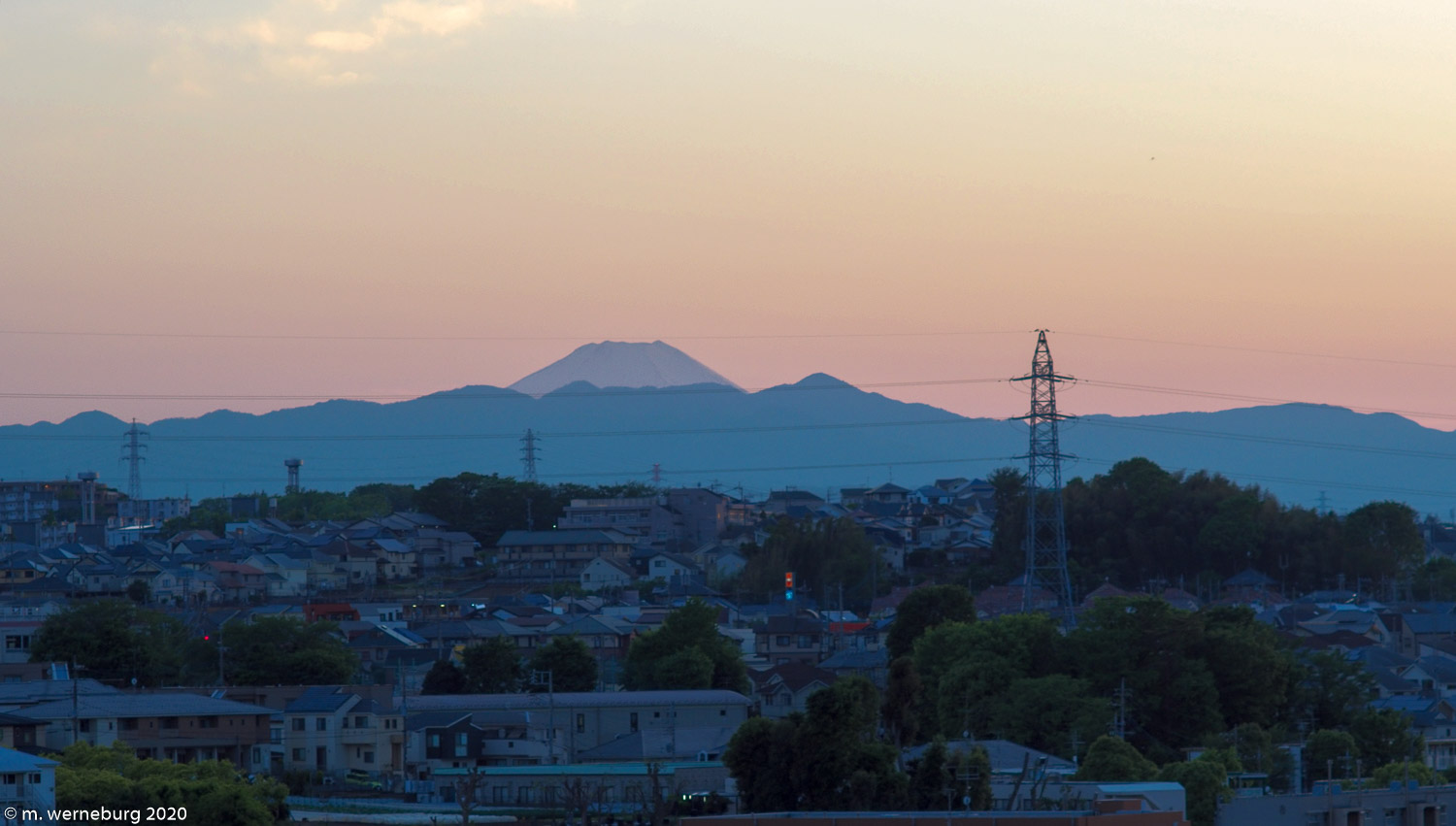
Mt. Fuji just after sunset - hand-held with Pentax SMC-K 28/F3.5
Not exactly a publishable photo but I was pleased with the result. It certainly shows off the color capture.
In normal use, the in-body image stabilization makes virtually any photo sharper. I thoroughly endorse what Olympus is doing here and it's a major reason that I've decided to stay with the four-thirds platform for life.
signs of trouble
For some reason, the outer surface of the camera is degrading in a way that I find troubling. The "silver" front of the body, surrounding the lens mount, is losing its paint. This seems to be coming from simple handling; it's not like I wear sandpaper gloves while using the camera. You can see it clearly in this image:
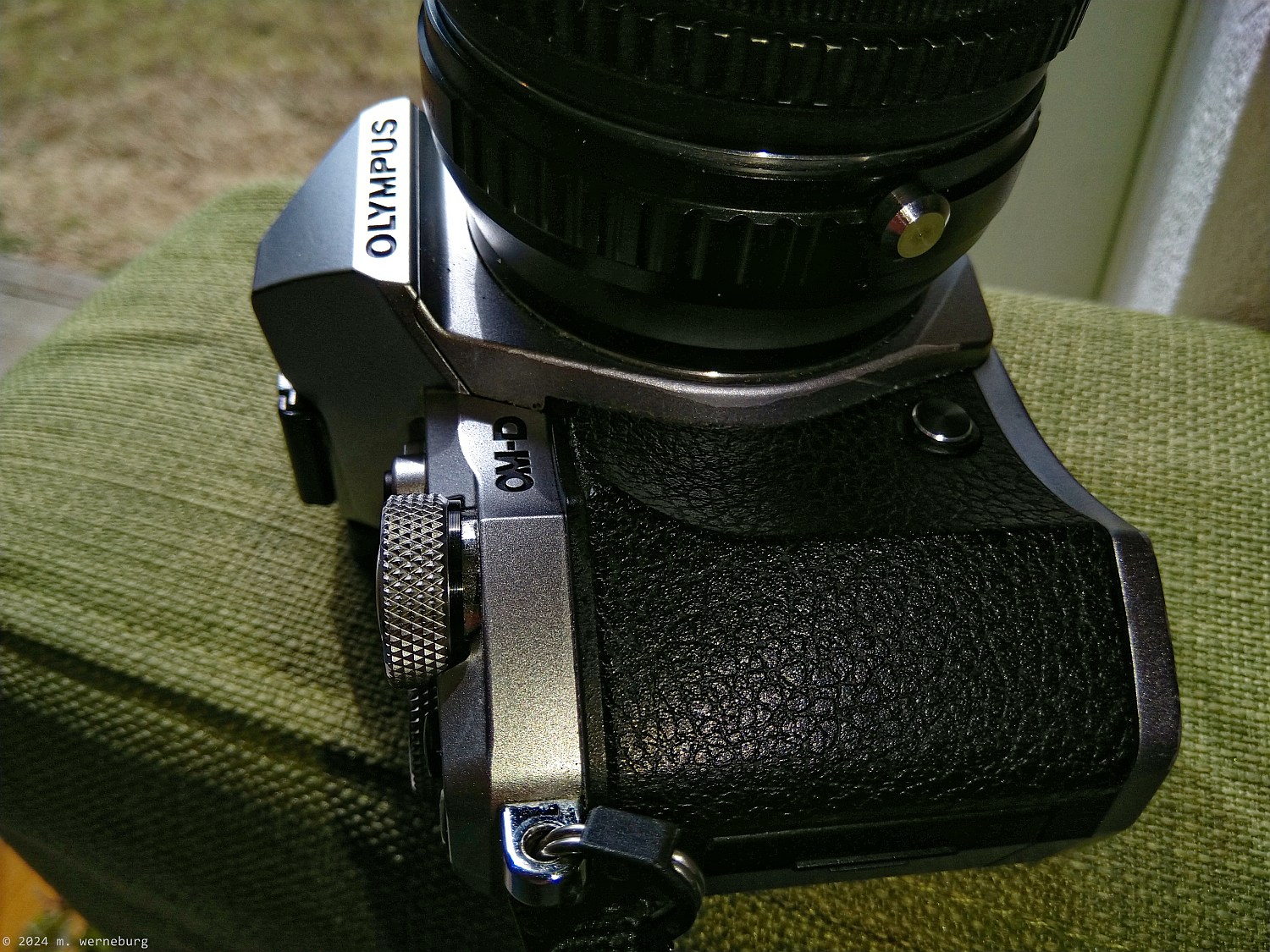
signs of wear on the EM-5 MkII body?
I don't know what to make of this, but wondered if flex in the camera body could have been a factor. I wonder if this camera's "retro" design got a bit ahead of Olympus. Yes, it's weather sealed. Yes, it's packed with capabilities. But what's going on here? Why should a $1,000+ camera body look like this after five years?
in conclusion
I've really enjoyed this camera and have been pleased with the results. It's really that simple. I don't know that this camera was the perfect choice for me, but with 7,500 frames taken I'm certainly not looking at any replacements. Olympus divested itself of its camera business last year. This is something that's already happened to the other gear manufacturers I used in the past - first Minolta, then Pentax. It's a tough game and the good times are never coming back for manufacturers. As long as this body holds up, I'll gladly use it and then continue with the same series or something else in the four-thirds environment.